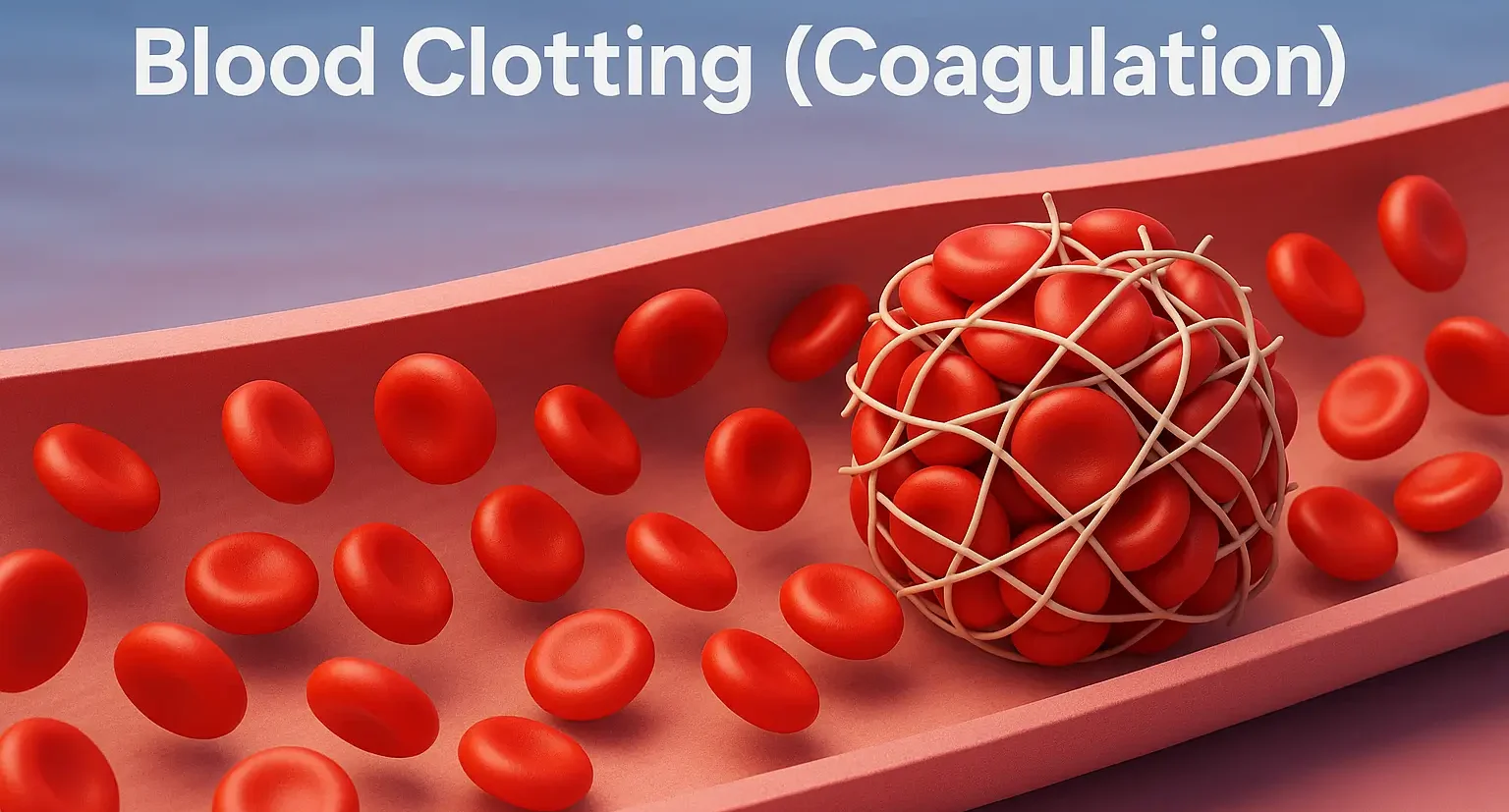Definition of Blood Clotting (Coagulation):
- Blood clotting, or coagulation, is a complex physiological process that prevents excessive bleeding (hemostasis) when a blood vessel is injured.
- It involves platelets, clotting factors, and the coagulation cascade to form a stable fibrin clot.
Phases of Blood Clotting
-
Vascular Spasm (Vasoconstriction):
- Immediate narrowing of the blood vessel to reduce blood flow.
-
Platelet Plug Formation (Primary Hemostasis):
- Platelet Adhesion: Platelets stick to exposed collagen in damaged blood vessels.
- Platelet Activation: Platelets release chemicals (ADP, thromboxane A2) to attract more platelets.
- Platelet Aggregation: Platelets form a temporary plug.
-
Coagulation Cascade (Secondary Hemostasis):
- Sequential activation of clotting factors leads to the formation of a fibrin mesh that stabilizes the platelet plug.
-
Clot Retraction and Repair:
- The clot contracts to reduce size and facilitate tissue repair.
-
Clot Dissolution (Fibrinolysis):
- Plasmin breaks down the clot once healing is complete.
Coagulation Pathways
-
Intrinsic Pathway (Contact Activation):
- Activated by damage inside blood vessels.
- Factors: XII → XI → IX → VIII → X.
-
Extrinsic Pathway (Tissue Factor Pathway):
- Activated by external trauma releasing tissue factor (TF).
- Factors: TF → VII → X.
-
Common Pathway:
- Both pathways converge at Factor X, activating thrombin.
- Thrombin converts fibrinogen into fibrin, forming the final clot.
Key Clotting Factors
- Factor I: Fibrinogen – Converted to fibrin.
- Factor II: Prothrombin – Converted to thrombin.
- Factor III: Tissue factor (TF) – Activates extrinsic pathway.
- Factor IV: Calcium – Essential cofactor in clotting.
- Factor VIII and IX: Deficiencies cause Hemophilia A and B.
- Factor XIII: Cross-links fibrin to stabilize the clot.
Advertisements
Disorders of Blood Clotting
-
Bleeding Disorders (Hypocoagulable States):
- Hemophilia (A – Factor VIII, B – Factor IX deficiency).
- Von Willebrand Disease: Defective platelet adhesion.
- Thrombocytopenia: Low platelets.
- Liver Disease: Impaired clotting factor synthesis.
- Vitamin K Deficiency: Affects Factors II, VII, IX, X.
-
Excessive Clotting Disorders (Hypercoagulable States):
- Deep Vein Thrombosis (DVT): Clots in deep veins.
- Pulmonary Embolism (PE): Clot migration to lungs.
- Disseminated Intravascular Coagulation (DIC): Widespread clotting followed by bleeding.
- Thrombophilia: Genetic predisposition (e.g., Factor V Leiden).
Diagnosis
-
Coagulation Tests:
- PT (Prothrombin Time): Extrinsic pathway, monitors warfarin.
- INR: Standardized PT value.
- aPTT (Activated Partial Thromboplastin Time): Intrinsic pathway, monitors heparin.
- Thrombin Time (TT): Fibrinogen conversion assessment.
-
Platelet Tests:
- Count and Bleeding Time: Platelet number and function.
-
Special Tests:
- D-Dimer: Detects clot breakdown products (DVT, PE).
- Fibrinogen Levels: Checks for deficiencies.
- Factor Assays: Identifies specific deficiencies.
Treatment
-
Bleeding Disorders:
- Replacement Therapy: Clotting factors (Factor VIII for Hemophilia A).
- Desmopressin (DDAVP): Releases von Willebrand factor.
- Vitamin K Supplementation: For deficiencies.
- Platelet Transfusion: In thrombocytopenia.
-
Clotting Disorders (Hypercoagulability):
- Anticoagulants:
- Heparin: Immediate effect (intrinsic pathway).
- Warfarin: Long-term use (extrinsic pathway).
- DOACs: Apixaban, Rivaroxaban.
- Thrombolytics (Fibrinolytics): Alteplase for DVT, PE, stroke.
- Antiplatelets: Aspirin, Clopidogrel to prevent aggregation.
- Compression Therapy: Prevents clotting in immobile patients.
- Anticoagulants:
Complications
- Bleeding: From anticoagulants or clotting factor deficiencies.
- Thromboembolism: Migrating clots causing PE, stroke.
- Organ Damage: Hypoperfusion due to clots.
Prognosis
- Early Treatment: Improves survival and outcomes.
- Chronic Conditions: Require long-term management.
- Advances in Therapy: Improved outcomes for high-risk patients.
Advertisements

